Our tips on how to do Kyoto’s Golden Pavilion and Nijo Castle in one day
We caught the bus from Kyoto
Train station to the Golden Pavilion (also known as Kinkaku-ji) and Nijo Castle in April 2019. We used a 1
day bus ticket to travel to the Golden Pavilion and Nijo Castle in the same
day. Both places are in the same direction and the Bus route travels right past
Nijo Castle on the way to the Golden Pavilion so it made sense to us.
The Golden Pavilion was beautiful
and is a UNESCO World Heritage site. But it was incredibly crowded for such a
serene Instagram friendly place. This was one of the most crowded places I’ve
been to in Japan. It was almost ridiculous. The Pavilion is beautiful though and
sparkles with gold in the sunlight.
Nijo Castle was well worth
visiting. The castle is very beautiful with all the gold leaf embellishments.
We got to go inside the Palace and experience the ‘Nightingale floors’. What
are Nightingale floors you may ask? They are special floors designed to
chirp/squeak like a nightingale (bird) when an intruder or spy approaches. A
samurai could hear the chirping and know that a would-be assassin or
eavesdropper was around. There were so many tourists inside the palace – whole corridors
were chirping which made me laugh– but it was good to hear though! An unusual experience.
How
to get there? Bus? Train or Taxi?
There is no direct train to the Golden Pavilion. It was recommended by
many online to catch a taxi rather than the bus, the bus taking ‘too long’. We
however decided to take the bus. The bus took about 50 minutes - and it was great to look out the window and see
Kyoto. The bus also took us straight to the Golden Pavilion (a 5 minute walk)
and Nijo Castle (directly across the road!).
Where
do you get the bus passes from?
You can buy a Kyoto Bus 1 day
pass from the Bus Station shop (which is right next door to where the buses
depart at Kyoto Train Station). The Bus station is directly outside of the Kyoto train
station exit. It worked out cheaper for us to buy the 1 day bus pass. If you
don’t have a bus pass, you can just pay the driver – but you need exact money,
which can be a hassle if you are doing multiple trips. The drivers don’t give
you change apparently.
The Bus Station shop also sells very cheap bakery goods - I totally recommend!
The Bus Station shop also sells very cheap bakery goods - I totally recommend!
 |
| Kyoto Bus ticket |
You
enter Kyoto buses from the middle door not the driver door!
Once you have got your bus
ticket, you will stand in line and wait for the next Kyoto bus. I think they
come pretty regularly, like every 10 minutes or so. And when the bus comes, you
enter through the ‘exit door’ (middle door) of the bus (not where the driver
is). Any payment, you give to the driver at the end of your journey (or show
him your bus pass at the end of your trip).
We
went to the Golden Pavilion first
As said previously, the Golden
Pavilion was extremely busy. We went during the middle of the week and got
there about 11am. The place was jam packed full of tourists and it was hard
just to get a clear view of the Pavilion. All my photos had people on either side
of me as I jostled for a photo.
The bus has TV announcements of upcoming bus stops in English. After getting off the public bus at the Golden Pavilion bus stop – we probably walked about 5 minutes up a slight hill/pathway (no steps). If you follow the people heading that way you will not get lost. There is a ticket office before you go in where you can buy your tickets – the tickets by the way are really nice keepsakes with Japanese writing. An adult ticket is about 400 Yen.
 |
| Golden Pavilion ticket |
Once you have your tickets you
follow the pathway around to the Golden Pavilion. It is very pretty, and the photographic
goal is to get a perfect ‘reflection’ in the water of the Golden Pavilion. At
the right angle, you can get a view of the mirror image of the Golden Pavilion
reflected in the lake. The lake has a golden glow when the mirror image is
reflected.
The site dates back to 1397 but
the Golden Pavilion is not the original building – it was burned down. The
current structure dates back to 1955. The top two floors are coated in gold
leaf. There
is a bronze golden phoenix that sits at the top of the pavilion. Nearby there is the head
priest's former living quarters (you can’t go in here either). There are also
some nice temples within the Golden Pavilion grounds with nice garden features.
There are some statues that people throw coins at too in the garden. Other then that, there is not much else to see
here. We bought some lucky charm souvenirs at the temple. We probably spent
about an hour here walking from the bus stop to leaving the temple. Including
eating our lunch.
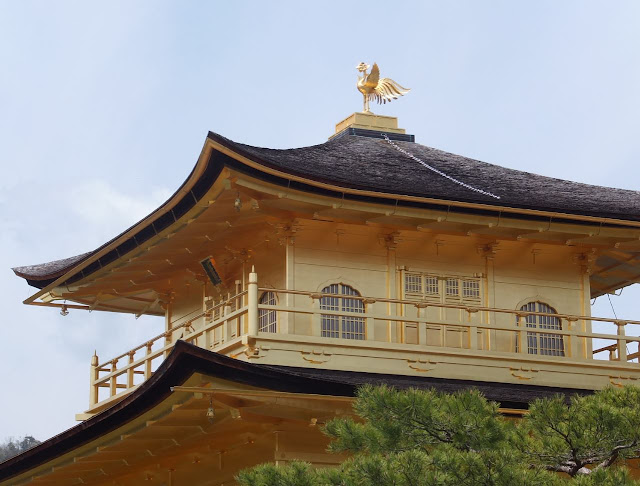 |
| You can see the golden Phoenix at the top of the temple. You can see the brighter the day the brighter the image of the temple in golden colour |
 |
| The bottom floor doors slide open. You can sometimes see statues that are located inside |
You cannot unfortunately go
inside the Golden Pavilion (I have seen pictures of the inside of the Golden Pavilion on
Google images– its all gold inside and seems to glow with all the gold– it would be amazing to see). The
inside of the Pavilion houses relics of Buddha. There are also some statues stored there, that may be viewed across the lake when the lower doors are opened.
There is a very small outdoor market at
the exit of the Golden Pavilion where you can get some lunch or as we did Matcha
ice-creams! We brought our own lunch with us (from the Kyoto Bus Station shop). Even though there are food
options there at the market, it was more convenient to bring our own –and cheaper.
 |
| Matcha Icecream |
Best
to go to the Golden Pavilion on a sunny day!
I think to get the best pictures,
you would want to be there on a sunny day when the gold leaf reflects in the sun. This is also when the gold leaf reflects
the best on the pond. You won’t get the same pictures of the reflection in the rain
– however, the temple is still beautiful to see anytime and would be less
crowded on a rainy day. Be aware that there isn’t a lot of shelter at all in
the rain though.
There
are some stairs towards the end of the pathway
For those who ask about wheelchair accessibility
or have strollers, there are some stairs towards the end of the pathway to the
exit. There aren’t that many, but they are there. Maybe 5 minutes of walking
upstairs. If you can’t do steps, you could probably exit through the front entrance
though (which has no steps).
Note
the Golden Pavilion closes at 5pm, with last admission 4pm
This closure time didn’t affect
us for the Golden Pavilion, but it has elsewhere in Japan. Always take note when the last admission time
is and when it actually closes.
Next
stop Nijo Castle
The bus does a bit of a loop back
to Kyoto Station, and on the way back it stops by Nijo Castle. Go back to the
bus stop the Kyoto bus dropped you at the Golden Pavilion (don’t do what we did
and think we had to go to the other side of the road for the return journey).
The journey from the Golden Pavilion to Nijo Castle took probably about 20 minutes.
 |
| The outer entrance to Nijo Castle is surrounded by a moat |
 |
| The entrance to Nijo Castle |
We
paid for a ticket to the Palace and the Nijo Castle Grounds
Nijo Castle is also a UNESCO
world heritage site and dates back to 1626. Note that to go inside the Ninomaru
Palace you need to pay an additional fee. There is also another palace called
the Honmaru Palace which we did not go inside and involves another fee.
The first stop we made was to go
inside the Ninomaru Palace! The palace was where the Shogun lived and
resided with his lady attendants. The Shogun would receive visitors, and the
more highly ranked the visitor – the further inside the palace they were
allowed.
The interior of the Ninomaru
Palace takes about 20 minutes and is self guided. You travel from room to room
to see what each room was used for. There are ample descriptions in English. The
rooms are not furnished at all, its mostly just flooring and wall pictures –
golden wall sized pictures of tigers, cherry blossoms or birds. Some of the artwork originals
have been safely put into an extra museum with an additional charge. Honmaru Palace is also on the Castle
grounds however is closed until 2021 due to earthquake resistance restoration and maintenance.
 |
| The entrance to the Ninomaru Palace |
Ninomaru Palace is where you
experience the Nightingale floors! The chirping floors were fun – and you can
only wear socks inside the palace– no shoes! You basically walk around with a
plastic bag carrying around your shoes inside the palace. There is a book
written about the Nightingale floors – I highly recommend – ‘Across the
Nightingale Floor’ by Lian Hearn.
Below are some of the artworks found inside Ninomaru Palace. These are on the sliding doors and walls and are quite large. Note that you cannot take photos whilst inside the Palace. My photos below are ones displayed on boards outside the museum entrance.
Below are some of the artworks found inside Ninomaru Palace. These are on the sliding doors and walls and are quite large. Note that you cannot take photos whilst inside the Palace. My photos below are ones displayed on boards outside the museum entrance.
 |
| The 'Cherry blossom room' was where the Shogun met with high ranking nobles. |
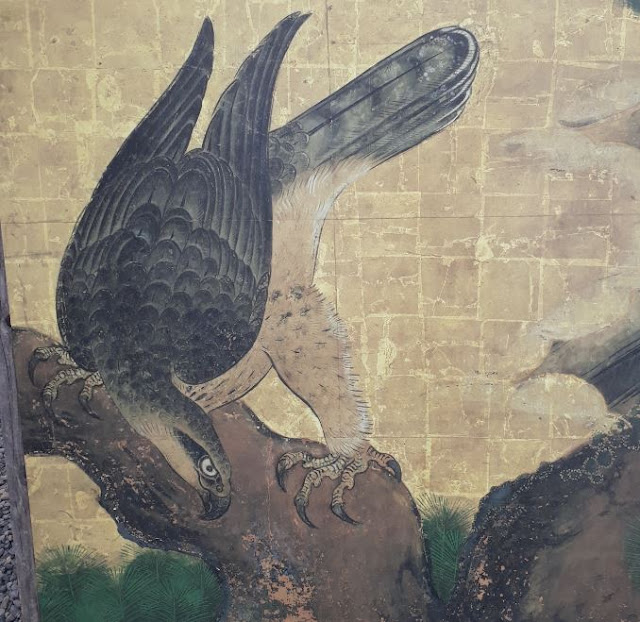 |
| The 'Hawk room' was said to be where the weapons were displayed when the Shogun was in residence |
 |
| The 'Tiger room' was the first room a visitor would see. Designed to express authority of the Shogun |
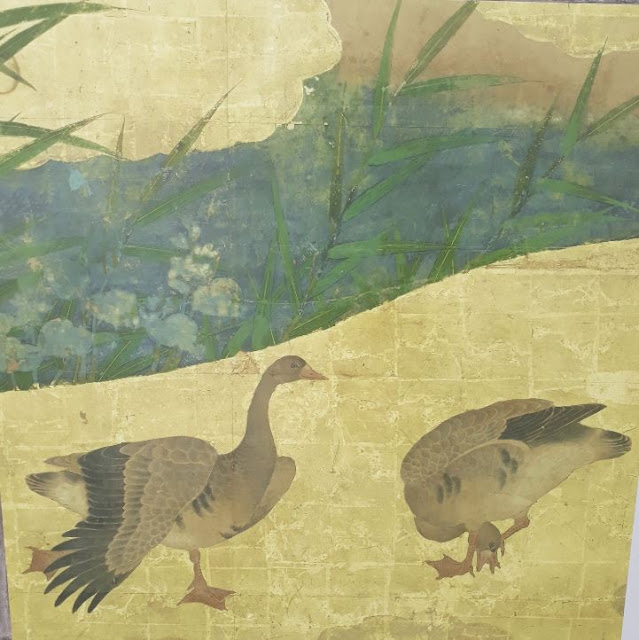 |
| The Geese and Egrets were in the room set aside for senior councillors |
It kind of felt like the room decor conveyed the mood of the room the Shogun wanted. Fierce Tigers for visitors waiting and Cherry blossoms for high ranking nobles.
Note, like the Golden Pavilion above, admission to the palace ends one hour before the official closing time.
How
much time do you need?
I would allow at least a couple
of hours to enjoy the inside of the palace, the museum and the gardens.
Visit
Nijo Castle in Spring to see the Cherry Blossoms
Many Cherry trees were flowering
at Nijo castle, and I took some great photos of the Cherry blossoms, both late
and early flowering. If you’ve missed Cherry Blossoms elsewhere in Japan, you
can always try here which has the late flowering blossoms. Apparently the
gardens are also beautiful in the autumn months too with the changing leaf
colours. There are reflective ponds and old bridges too to explore in the
palace gardens. It’s a great place to go for a walk and for kids to run around.
 |
| Ninomaru Palace gardens |
 |
| These are late flowering Cherry Blossoms |
Overall
Overall, we enjoyed our trip to
the Golden Pavilion and Nijo Castle, both worth a visit.
I would love to hear any comments from you - what are your tips regarding the Golden Pavilion and Nijo Castle in Japan?
You can also now follow us on
Facebook at https://www.facebook.com/themeparktravelguide/
Instagram at https://www.instagram.com/sotaram1 (my photos are all on this page)
You can also subscribe directly to this blog. I publish weekly, on a Wednesday
Subscribe to Theme Park Travel Guide by Email
More on Japan
Until next week,
KJ
You can also now follow us on
Facebook at https://www.facebook.com/themeparktravelguide/
Instagram at https://www.instagram.com/sotaram1 (my photos are all on this page)
You can also subscribe directly to this blog. I publish weekly, on a Wednesday
Subscribe to Theme Park Travel Guide by Email
Read more tips from my blog
Home PageMore on Japan
Until next week,
This site may contain affiliate links. When you click on
a link, we receive a small percentage of an affiliate sale without
any cost to you. Thank you for your support!
This Website is neither endorsed nor affiliated with any
Disney Park or Universal Studios park worldwide. This website is unofficial. To
avoid disappointment please always check the official websites for current
details of rides etc. Please read my full
Disclaimer
here.






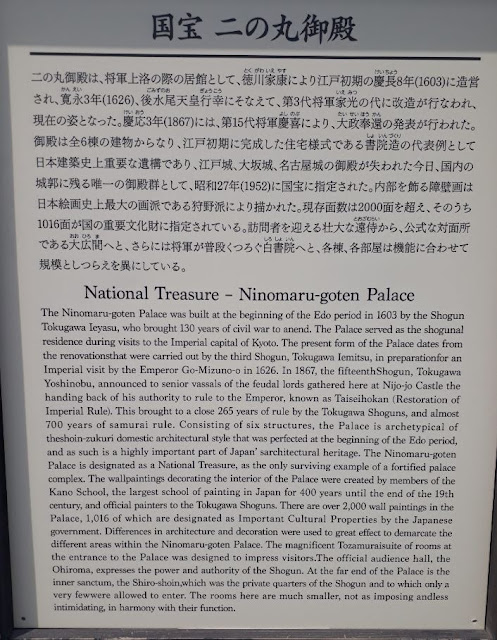

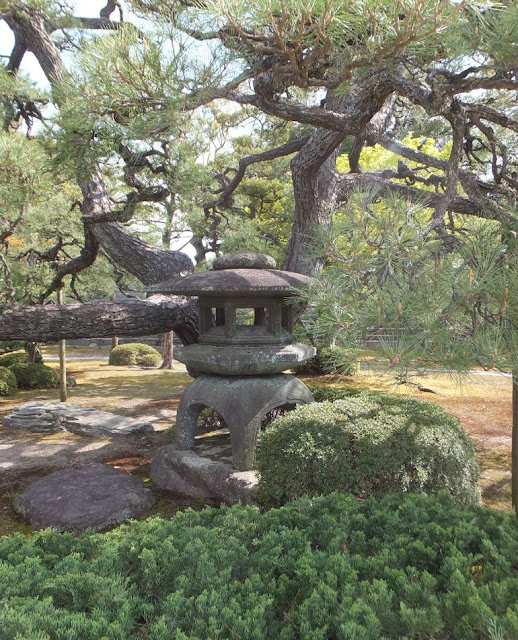


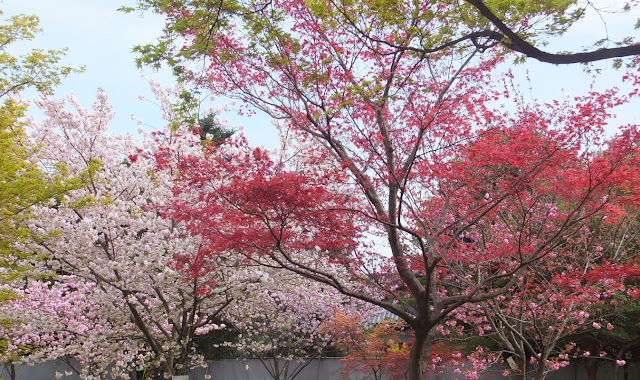








Comments